2008 CHEVROLET HHR height
[x] Cancel search: heightPage 5 of 430
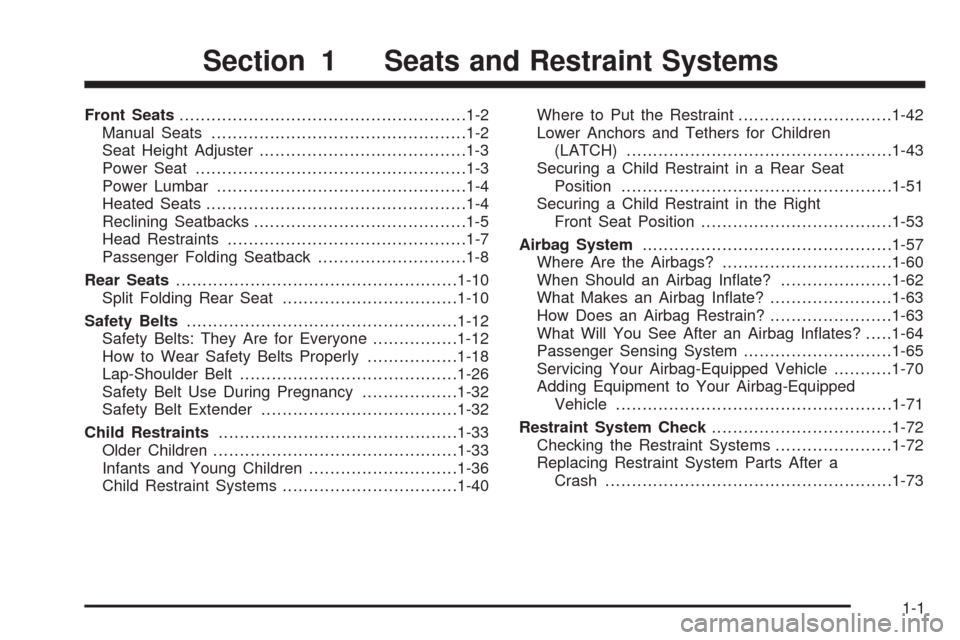
Front Seats......................................................1-2
Manual Seats................................................1-2
Seat Height Adjuster.......................................1-3
Power Seat...................................................1-3
Power Lumbar...............................................1-4
Heated Seats.................................................1-4
Reclining Seatbacks........................................1-5
Head Restraints.............................................1-7
Passenger Folding Seatback............................1-8
Rear Seats.....................................................1-10
Split Folding Rear Seat.................................1-10
Safety Belts...................................................1-12
Safety Belts: They Are for Everyone................1-12
How to Wear Safety Belts Properly.................1-18
Lap-Shoulder Belt.........................................1-26
Safety Belt Use During Pregnancy..................1-32
Safety Belt Extender.....................................1-32
Child Restraints.............................................1-33
Older Children..............................................1-33
Infants and Young Children............................1-36
Child Restraint Systems.................................1-40Where to Put the Restraint.............................1-42
Lower Anchors and Tethers for Children
(LATCH)..................................................1-43
Securing a Child Restraint in a Rear Seat
Position...................................................1-51
Securing a Child Restraint in the Right
Front Seat Position....................................1-53
Airbag System...............................................1-57
Where Are the Airbags?................................1-60
When Should an Airbag In�ate?.....................1-62
What Makes an Airbag In�ate?.......................1-63
How Does an Airbag Restrain?.......................1-63
What Will You See After an Airbag In�ates?.....1-64
Passenger Sensing System............................1-65
Servicing Your Airbag-Equipped Vehicle..........
.1-70
Adding Equipment to Your Airbag-Equipped
Vehicle....................................................1-71
Restraint System Check..................................1-72
Checking the Restraint Systems......................1-72
Replacing Restraint System Parts After a
Crash......................................................1-73
Section 1 Seats and Restraint Systems
1-1
Page 7 of 430
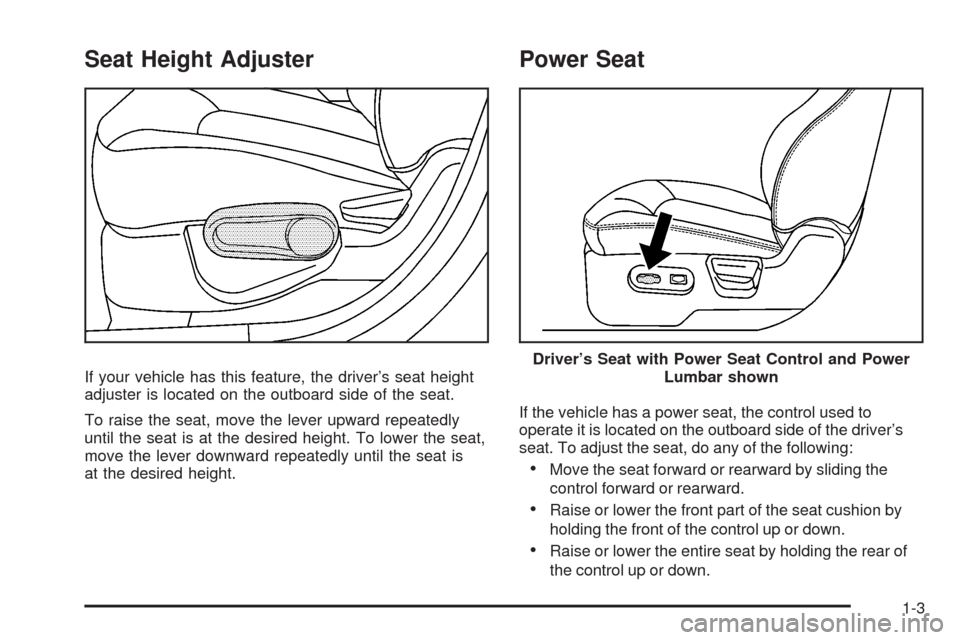
Seat Height Adjuster
If your vehicle has this feature, the driver’s seat height
adjuster is located on the outboard side of the seat.
To raise the seat, move the lever upward repeatedly
until the seat is at the desired height. To lower the seat,
move the lever downward repeatedly until the seat is
at the desired height.
Power Seat
If the vehicle has a power seat, the control used to
operate it is located on the outboard side of the driver’s
seat. To adjust the seat, do any of the following:
Move the seat forward or rearward by sliding the
control forward or rearward.
Raise or lower the front part of the seat cushion by
holding the front of the control up or down.
Raise or lower the entire seat by holding the rear of
the control up or down.
Driver’s Seat with Power Seat Control and Power
Lumbar shown
1-3
Page 11 of 430
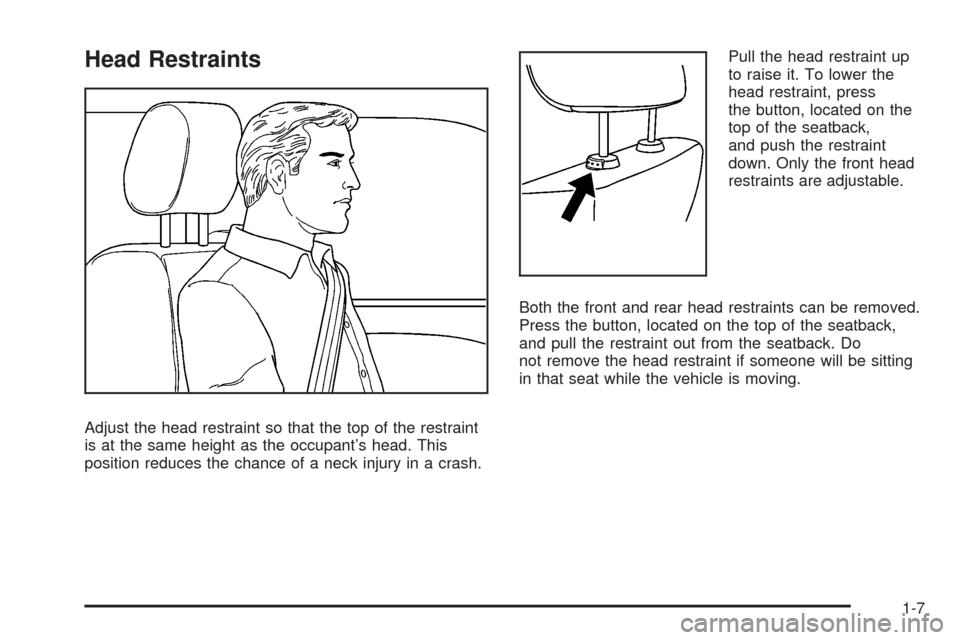
Head Restraints
Adjust the head restraint so that the top of the restraint
is at the same height as the occupant’s head. This
position reduces the chance of a neck injury in a crash.Pull the head restraint up
to raise it. To lower the
head restraint, press
the button, located on the
top of the seatback,
and push the restraint
down. Only the front head
restraints are adjustable.
Both the front and rear head restraints can be removed.
Press the button, located on the top of the seatback,
and pull the restraint out from the seatback. Do
not remove the head restraint if someone will be sitting
in that seat while the vehicle is moving.
1-7
Page 30 of 430
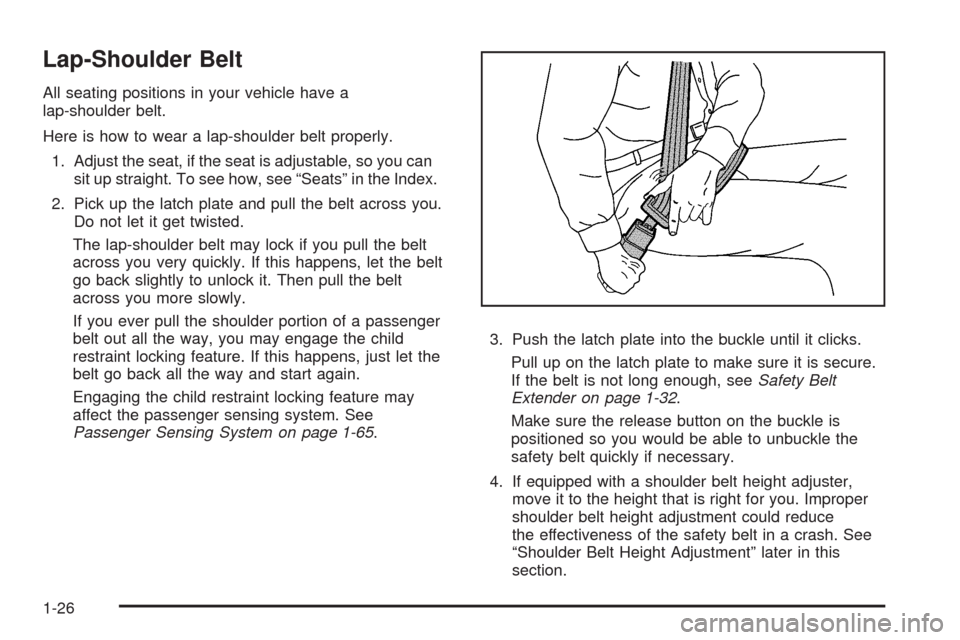
Lap-Shoulder Belt
All seating positions in your vehicle have a
lap-shoulder belt.
Here is how to wear a lap-shoulder belt properly.
1. Adjust the seat, if the seat is adjustable, so you can
sit up straight. To see how, see “Seats” in the Index.
2. Pick up the latch plate and pull the belt across you.
Do not let it get twisted.
The lap-shoulder belt may lock if you pull the belt
across you very quickly. If this happens, let the belt
go back slightly to unlock it. Then pull the belt
across you more slowly.
If you ever pull the shoulder portion of a passenger
belt out all the way, you may engage the child
restraint locking feature. If this happens, just let the
belt go back all the way and start again.
Engaging the child restraint locking feature may
affect the passenger sensing system. See
Passenger Sensing System on page 1-65.3. Push the latch plate into the buckle until it clicks.
Pull up on the latch plate to make sure it is secure.
If the belt is not long enough, seeSafety Belt
Extender on page 1-32.
Make sure the release button on the buckle is
positioned so you would be able to unbuckle the
safety belt quickly if necessary.
4. If equipped with a shoulder belt height adjuster,
move it to the height that is right for you. Improper
shoulder belt height adjustment could reduce
the effectiveness of the safety belt in a crash. See
“Shoulder Belt Height Adjustment” later in this
section.
1-26
Page 32 of 430
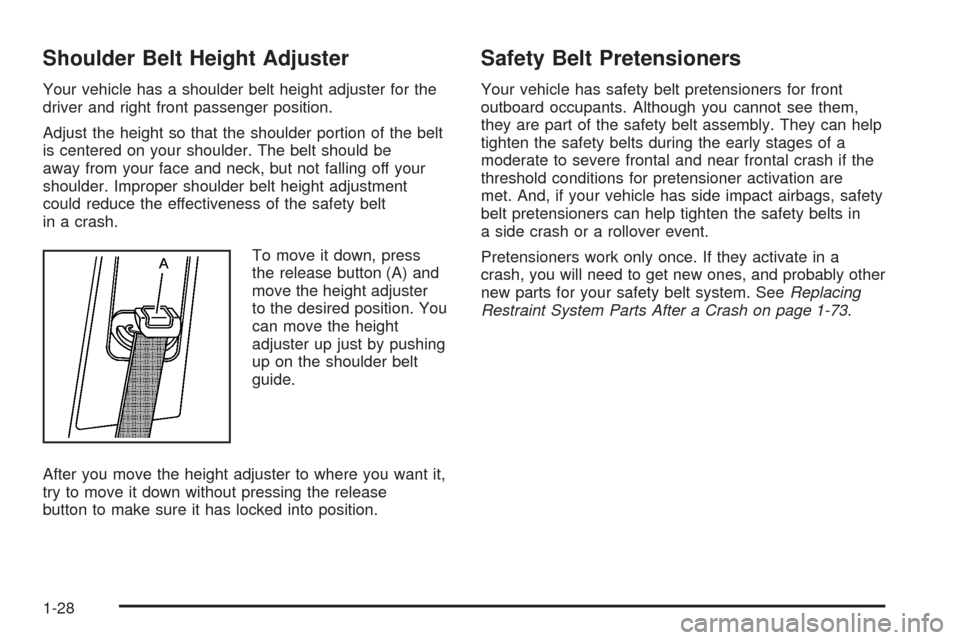
Shoulder Belt Height Adjuster
Your vehicle has a shoulder belt height adjuster for the
driver and right front passenger position.
Adjust the height so that the shoulder portion of the belt
is centered on your shoulder. The belt should be
away from your face and neck, but not falling off your
shoulder. Improper shoulder belt height adjustment
could reduce the effectiveness of the safety belt
in a crash.
To move it down, press
the release button (A) and
move the height adjuster
to the desired position. You
can move the height
adjuster up just by pushing
up on the shoulder belt
guide.
After you move the height adjuster to where you want it,
try to move it down without pressing the release
button to make sure it has locked into position.
Safety Belt Pretensioners
Your vehicle has safety belt pretensioners for front
outboard occupants. Although you cannot see them,
they are part of the safety belt assembly. They can help
tighten the safety belts during the early stages of a
moderate to severe frontal and near frontal crash if the
threshold conditions for pretensioner activation are
met. And, if your vehicle has side impact airbags, safety
belt pretensioners can help tighten the safety belts in
a side crash or a rollover event.
Pretensioners work only once. If they activate in a
crash, you will need to get new ones, and probably other
new parts for your safety belt system. SeeReplacing
Restraint System Parts After a Crash on page 1-73.
1-28
Page 37 of 430
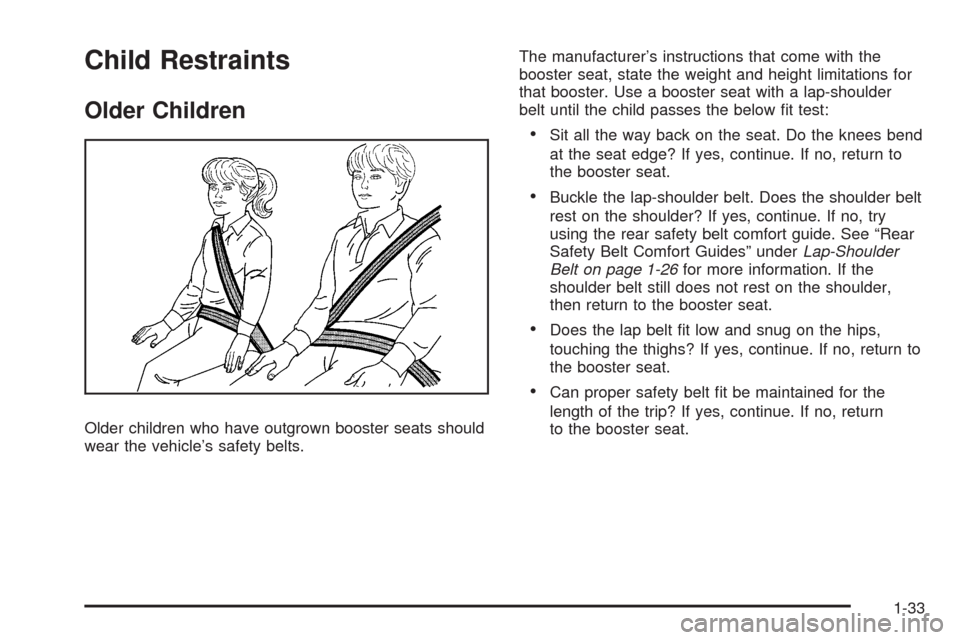
Child Restraints
Older Children
Older children who have outgrown booster seats should
wear the vehicle’s safety belts.The manufacturer’s instructions that come with the
booster seat, state the weight and height limitations for
that booster. Use a booster seat with a lap-shoulder
belt until the child passes the below �t test:
Sit all the way back on the seat. Do the knees bend
at the seat edge? If yes, continue. If no, return to
the booster seat.
Buckle the lap-shoulder belt. Does the shoulder belt
rest on the shoulder? If yes, continue. If no, try
using the rear safety belt comfort guide. See “Rear
Safety Belt Comfort Guides” underLap-Shoulder
Belt on page 1-26for more information. If the
shoulder belt still does not rest on the shoulder,
then return to the booster seat.
Does the lap belt �t low and snug on the hips,
touching the thighs? If yes, continue. If no, return to
the booster seat.
Can proper safety belt �t be maintained for the
length of the trip? If yes, continue. If no, return
to the booster seat.
1-33
Page 42 of 430
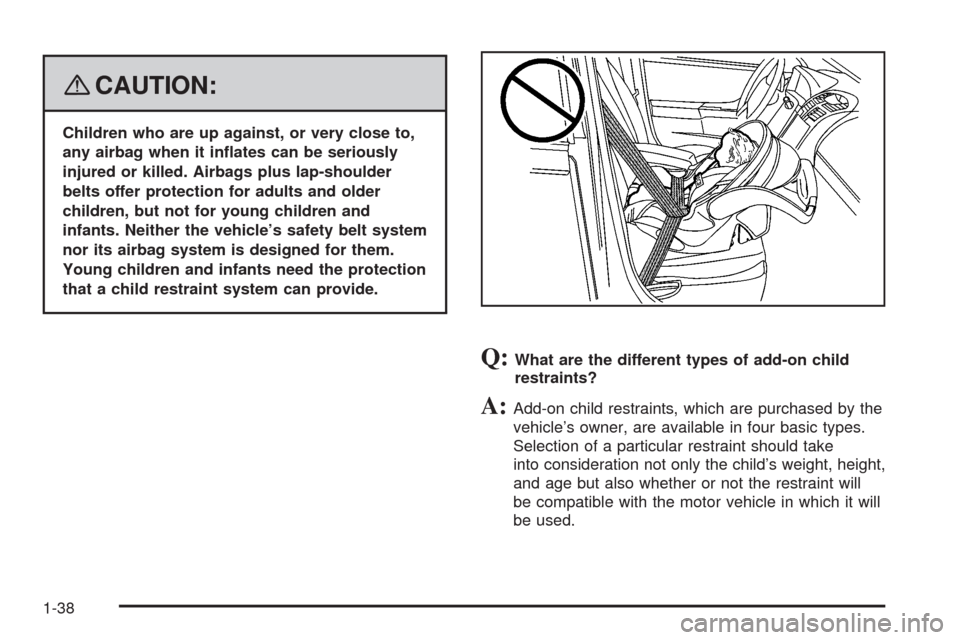
{CAUTION:
Children who are up against, or very close to,
any airbag when it in�ates can be seriously
injured or killed. Airbags plus lap-shoulder
belts offer protection for adults and older
children, but not for young children and
infants. Neither the vehicle’s safety belt system
nor its airbag system is designed for them.
Young children and infants need the protection
that a child restraint system can provide.
Q:What are the different types of add-on child
restraints?
A:Add-on child restraints, which are purchased by the
vehicle’s owner, are available in four basic types.
Selection of a particular restraint should take
into consideration not only the child’s weight, height,
and age but also whether or not the restraint will
be compatible with the motor vehicle in which it will
be used.
1-38
Page 43 of 430
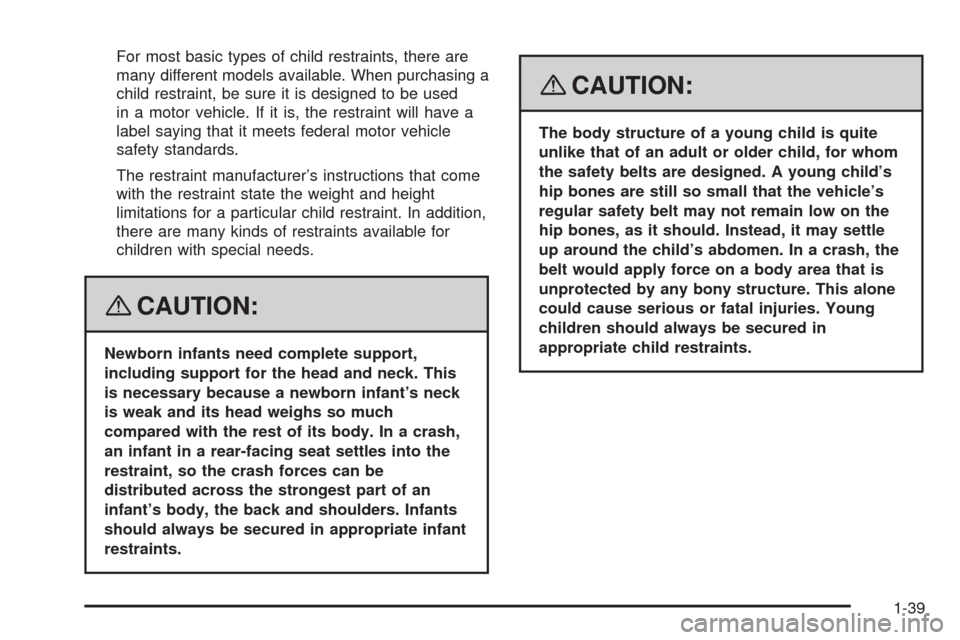
For most basic types of child restraints, there are
many different models available. When purchasing a
child restraint, be sure it is designed to be used
in a motor vehicle. If it is, the restraint will have a
label saying that it meets federal motor vehicle
safety standards.
The restraint manufacturer’s instructions that come
with the restraint state the weight and height
limitations for a particular child restraint. In addition,
there are many kinds of restraints available for
children with special needs.
{CAUTION:
Newborn infants need complete support,
including support for the head and neck. This
is necessary because a newborn infant’s neck
is weak and its head weighs so much
compared with the rest of its body. In a crash,
an infant in a rear-facing seat settles into the
restraint, so the crash forces can be
distributed across the strongest part of an
infant’s body, the back and shoulders. Infants
should always be secured in appropriate infant
restraints.
{CAUTION:
The body structure of a young child is quite
unlike that of an adult or older child, for whom
the safety belts are designed. A young child’s
hip bones are still so small that the vehicle’s
regular safety belt may not remain low on the
hip bones, as it should. Instead, it may settle
up around the child’s abdomen. In a crash, the
belt would apply force on a body area that is
unprotected by any bony structure. This alone
could cause serious or fatal injuries. Young
children should always be secured in
appropriate child restraints.
1-39